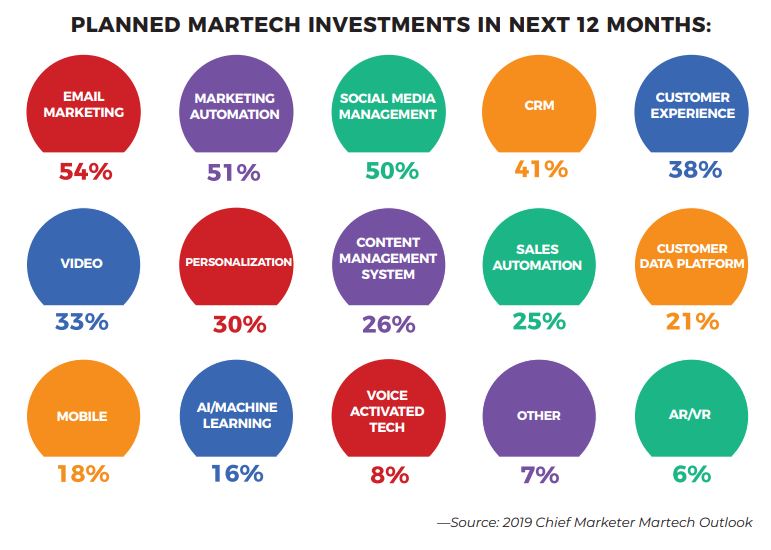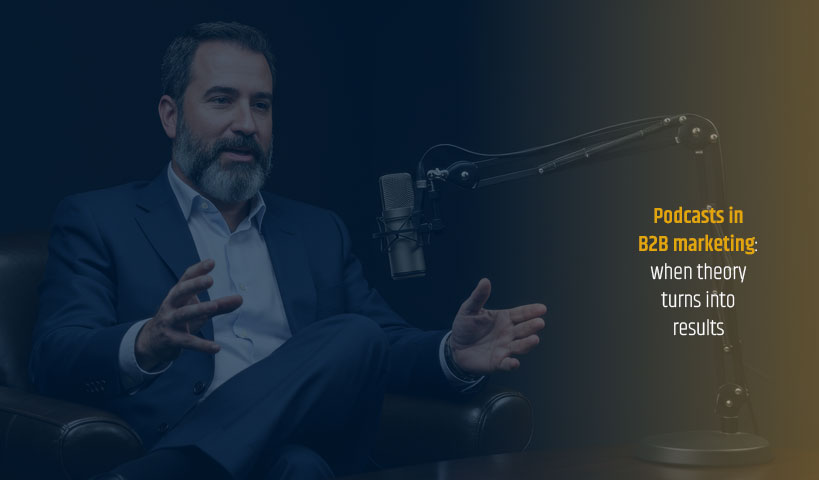
This may sound funny to you, but if you think about it, there are currently more than 7,000 marketing applications listed in the chart published each year by Scott Brinker of chiefmatech.com.

A sea of martech
They are listed in six major categories of marketing or “martech” technologies:
- Advertising and promotion
- Content and experience
- Social and relational
- Trade and sales
- Data
- Management
These broad categories are then divided into subcategories. The Content category (surrounded in red above) includes ten subcategories in which there are 1,689 different applications, nearly 25% of the total.
Do you see the complexity of choosing when it comes to, for example, developing a content strategy or more generally a marketing transformation strategy?
Too many choices can often lead to a bad decision…
It’s a bit like the content itself. There is an «obesity» in the martech offer that doesn’t help to make the right choices as pointed out by a study done by CMI, i.e. the 2019 Content Management and Strategy Survey.
According to this study, only 16% of respondents say they have the right technologies and use them to their full potential.

And the number of technologies is only growing despite some shortness of breath in 2019 with a growth of only 7%.

Source: Marketing Technology Landscape 2019
But according to Scott Brinker, the author of these charts since 2011, his annual tally does not even take into account several other possible categories.
Example: WordPress alone would have 54,880 plug-ins. Plug-ins are not part of the chart but are still mini-applications, many of which strictly serve the marketing function.

However, it still asks two important questions.
At only 7% increase, has the martech ecosystem reached its saturation point or only a plateau before resuming its growth?
And if so, when is the inevitable skimming or consolidating of technologies?
AI, consolidation and marketing transformation
Let’s leave the answer to Michael Brenner, CEO of Marketing Insider Group.
In a recent post, he included this consolidation in what is now known as marketing transformation:
«It must encompass your company culture (and be):
– a complete reinvention of your operating model,
– a restructuring of your marketing processes, marketing capabilities that can shift with every change in your market,
– an omnichannel approach,
– and to support it all – software as agile as your new organization.»
And the author gives the example of consolidation and transformation that IBM’s Watson represents:
Hence our question as a title but a little modified: marketing transformation: will AI force the consolidation of the “martech” panorama from an omnichannel perspective?
Will it be one of the main factors of consolidation in the marketing technology landscape? And if so, when? And if not, what impact will it have on the panorama? Just one more?
Asking these questions today implies that companies are firmly engaged in a process of digital transformation and approach to artificial intelligence in marketing.
The human, always the human…
But the reality of Quebec SMEs and even large companies is quite different, as we pointed out in a previous blog post.
“The reality in the trenches is quite different. Even in very large B2B companies, the penetration rate of martech is still very low. Apart from CRM and marketing automation, which, it should be noted, is currently limited to automated e-mailing in almost all cases.”
Alain Thériault

Proof of Alain’s statement: even in the USA, automation and CRM are two of the four largest investments planned by the CMOs for the next twelve months…
Still… The digital transformation of business and marketing is a must. It affects technology and many other areas within the company but above all, it impacts the human.
Any digital transformation of businesses requires taking into account users, planners or developers and giving them the right tools.
And in many cases, it’s not going as well and as fast as expected.
Let’s take the example of content marketing:
«…ultimately, no matter how much technology is thrown at it, content is created, managed, judged, optimized, and measured by people. Just as it’s not the things people buy that are responsible for credit card debt, it’s not the technology’s fault that marketers have an inability to leverage it to the fullest.»
Michael Brenner
Doesn’t that remind you of the 16% statistic?
As a member of the NextBlue Alliance, a group of companies offering IBM Watson Artificial Intelligence-based solutions, ExoB2B is well positioned to help your business in your digital shift. Contact us!




